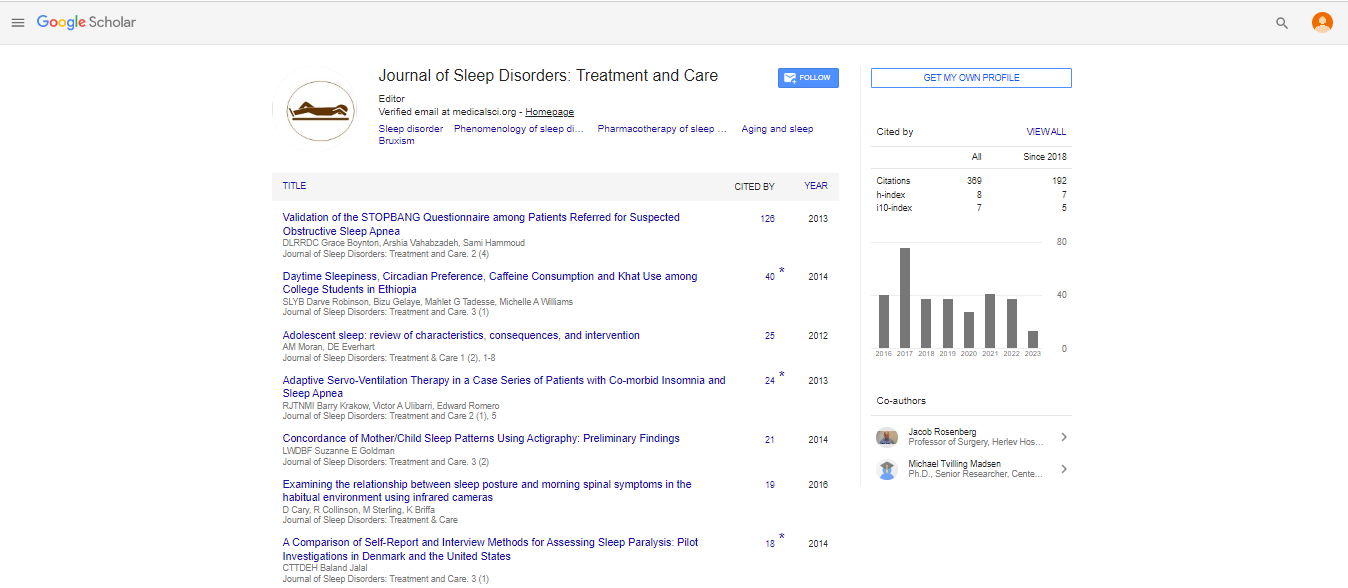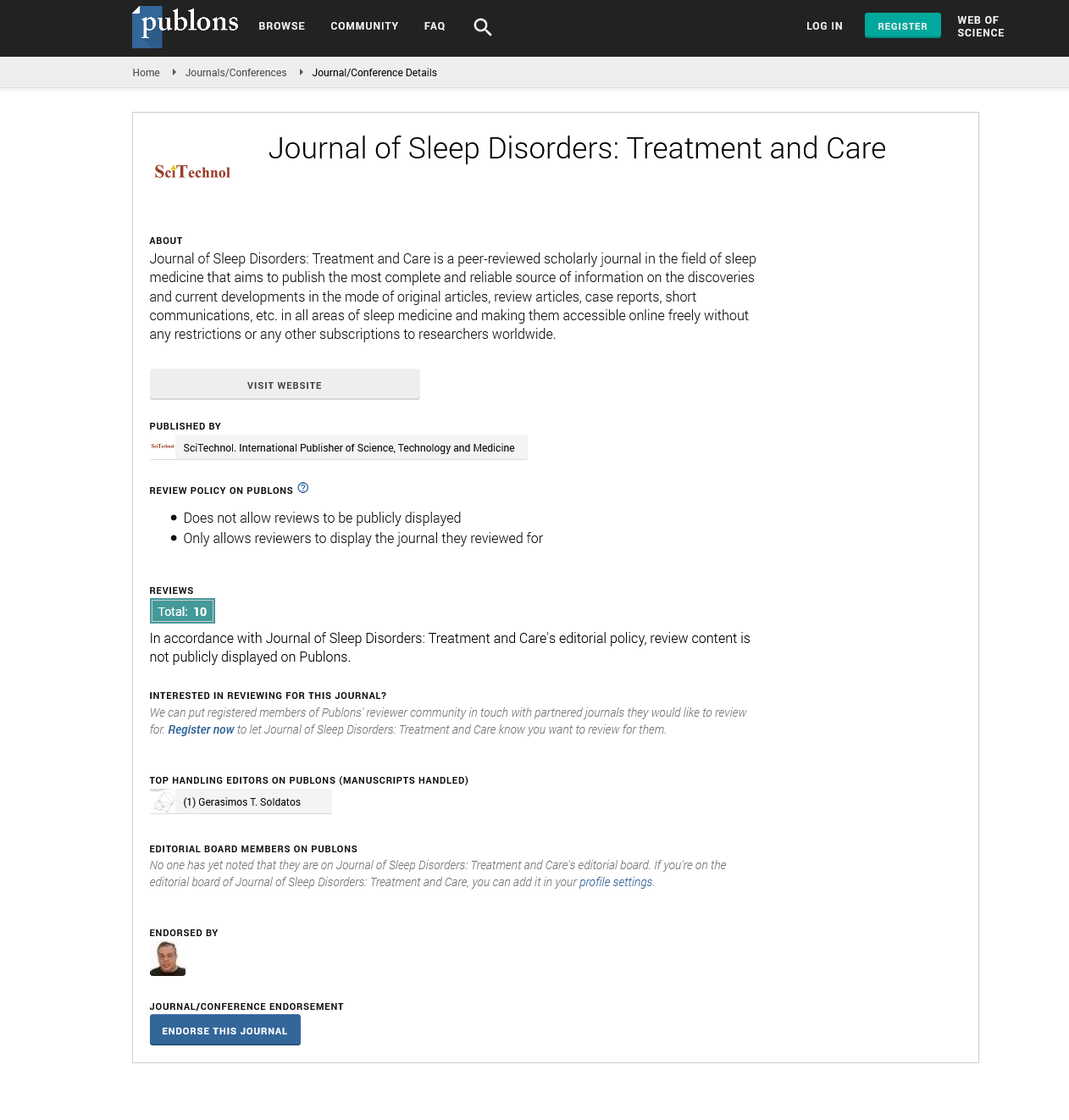Perspective, J Sleep Disor Treat Care Vol: 13 Issue: 1
Pediatric Insomnia: Causes and Treatment Approaches for Children
Yang Leng*
1Department of Psychiatry, Prince of Wales Hospital, Chinese University of Hong Kong, China
*Corresponding Author: Yang leng,
Department of Psychiatry, Prince of Wales
Hospital, Chinese University of Hong Kong, China
E-mail: yangleg@gmail.com
Received date: 19 September, 2024, Manuscript No. JSDTC-24-148330;
Editor assigned date: 23 September, 2024, PreQC No. JSDTC-24-148330 (PQ);
Reviewed date: 07 October, 2024, QC No. JSDTC-24-148330;
Revised date: 14 October, 2024, Manuscript No. JSDTC-24-148330 (R);
Published date: 21 October, 2024, DOI: 10.4172/2325-9639.1000159.
Citation: Leng Y (2024) Pediatric Insomnia: Causes and Treatment Approaches for Children. J Sleep Disor Treat Care 13:1.
Abstract
Description
Pediatric insomnia, characterized by difficulties in falling asleep, staying asleep, or experiencing non-restorative sleep, affects a significant number of children and can have deep implications for their overall health and development. Understanding the causes of insomnia in children and examining effective treatment approaches are crucial for addressing this common sleep disorder. The causes of pediatric insomnia can be multifaceted, often involving a combination of behavioral, environmental and medical factors. One major contributor is behavioral issues. Children may develop poor sleep habits, such as irregular sleep schedules or excessive screen time before bed, which can disrupt their natural sleep-wake cycles. Additionally, children who experience anxiety or stress, whether related to school, social situations, or family dynamics, may struggle with falling asleep or maintaining sleep throughout the night.
Environmental factors also play a significant role in pediatric insomnia. For instance an uncomfortable or disruptive sleep environment-such as a room that is too noisy, too bright, or inadequately furnished can hinder a child's ability to fall and stay asleep. Similarly, inconsistent bedtime routines or insufficient parental guidance regarding sleep practices can exacerbate sleep difficulties. Medical conditions are another important factor. Conditions such as asthma, allergies and gastrointestinal issues can interfere with sleep by causing discomfort or pain. Additionally, sleep disorders such as sleep apnea, restless leg syndrome and periodic limb movement disorder can directly impact a child's ability to achieve restful sleep. Medications for these conditions may also have side effects that affect sleep patterns.
Addressing pediatric insomnia requires a comprehensive approach that targets the underlying causes and incorporates effective treatment strategies. One of the most successful methods is Cognitive- Behavioral Therapy for Insomnia (CBT-I), which focuses on changing negative thought patterns and behaviors related to sleep. CBT-I for children often includes techniques such as establishing a consistent sleep schedule, creating a relaxing bedtime routine and reducing sleep-associated anxiety. Behavioral interventions also emphasize the importance of a sleep-conducive environment, such as a dark, quiet and cool room. Improving sleep hygiene is another critical component of treatment. This involves educating parents and children about practices that promote healthy sleep, such as limiting caffeine and screen time before bed, encouraging physical activity during the day and establishing a regular bedtime routine. Consistency is key, as maintaining a predictable sleep schedule helps regulate the child’s internal body clock, making it easier to fall asleep and stay asleep.
When behavioral and environmental strategies are insufficient, addressing underlying medical conditions may be necessary. For instance, managing asthma or allergies effectively can reduce nighttime awakenings and improve sleep quality. In cases where sleep disorders are identified, specific treatments, such as using a Continuous Positive Airway Pressure (CPAP) machine for sleep apnea or medication adjustments, may be required. Parental involvement is important in the treatment of pediatric insomnia. Parents should be encouraged to model healthy sleep behaviors and support their child in implementing sleep-friendly routines. Collaborating with healthcare providers to address any underlying medical issues and to develop a tailored treatment plan can also significantly enhance the effectiveness of interventions.
Pediatric insomnia is a complex issue with various potential causes, ranging from behavioral and environmental factors to medical conditions. A multifaceted approach, including behavioral interventions, sleep hygiene improvements and medical management when necessary, is essential for effectively addressing this disorder. By understanding the underlying causes and implementing appropriate treatment strategies, parents and healthcare providers can help children achieve better sleep and consequently, improve their overall well-being and development.
 Spanish
Spanish  Chinese
Chinese  Russian
Russian  German
German  French
French  Japanese
Japanese  Portuguese
Portuguese  Hindi
Hindi 
